It is December 10th, 2023 as of beginning to write this, and Doom has just turned 30 years old. Three decades of one of the most important video games ever made, both to gaming as a whole and to me personally. I have not been around for all 30 of those years, and despite playing and loving the reboots I really only recently started to appreciate the classic Doom games for what they’re truly worth. Even still, this game and this series has been so deeply important to me, and on its big 30th anniversary I see no better way to celebrate than to go in deep in appreciating it.

If you have, somehow, missed out on what Doom is, here’s the basic setup. You play as a space marine, nicknamed “Doomguy,” who is stationed on a base on Mars’ moon Phobos after hospitalizing a superior officer who ordered you to fire on civilians, like the righteous badass you are. Suddenly, all Hell breaks loose. Literally. Thanks to some teleportation experiments, demons now run amok on Phobos, and you’re the last man standing in their way.
Most of the detail here is from the manual, the game itself simplifies it even further. There are demons. You have guns. Figure it out.
If it wasn’t clear already, Doom takes its primary inspiration from 80s action, sci-fi, and horror movies, and it does a really good job of combining its influences into something new. The space marine and particular sci-fi setting feels a lot like Aliens (1986), but the demonic theming and the choices of weapons you’re given (primarily including a chainsaw and a shotgun) call to mind the Evil Dead series. The premise of a demonic invasion was inspired by a Dungeons & Dragons campaign the developers played in which a similar event happened. Even the title is a reference, although not to any of the previously mentioned genres. Rather, it originates from a scene in Martin Scorsese’s 1986 film The Color of Money.
Combining all of these creates a really fun and novel concept of technology vs Hell, guns vs demons. It feels a little oversaturated now, with the recent resurgence of Doom-inspired retro style shooters, and with demons being a fairly common enemy type in a lot of video games, but lead programmer John Carmack was cooking with gas when he came up with it back in the day.
Now, the important part, the actual gameplay… and some seriously impressive gameplay it is. Even after 3 decades of iteration on the genre that id Software basically invented, Doom is still nearly fucking perfect. They somehow managed to nail an incredible and satisfying FPS on the second go.
First and foremost to Doom’s immaculate design is its demons, because what is a shooter without things to shoot? While the lineup would be greatly improved on in the sequel, there is still a fantastic variety of monsters that all work together to provide a strong roster of foes for you to battle. Doom’s demons can be pretty neatly condensed into three categories: hitscan, projectile, and melee.
The first enemies you encounter are humans converted into demonic combatants, the zombiemen and the shotgun guys (these are both official names), although "shotgunners" sounds cleaner. While they have the weakest health of the entire lineup, their hitscan attacks being impossible to dodge give them a unique upper hand. Zombiemen still don’t cause much issue, their damage output is low and they only fire one shot every couple seconds. The shotgunners have a similar firerate, but the difference is they… you know, have a shotgun. Because of this, they remain considerable threats throughout the whole game and take a high priority in a group of demons. They’re easy to deal with, but you better deal with them early.


Next, the imp is the primary projectile demon you’ll be facing, with a fireball attack and slightly more health than the two hitscanners. With a fairly slow moving projectile attack, imps aren’t huge threats, but they are the first enemy to make you actually think about your movement and positioning rather than just pointing and shooting. Later on, you’ll encounter the cacodemon, a one-eyed many-horned flying red people eater with more health, a stronger fireball attack, and a huge bite if you’re foolish enough to get close. Finally, the baron of hell is presented as a duo boss at the end of episode 1, and then individuals become uncommon enemies for the rest of the game. Packing the biggest punch and the most health, they’re some of Hell’s toughest, at least until the sequel.



Finally, in the melee category, we have the simply named demon (in later games known as a pinky), and its translucent counterpart the spectre. This hunchback has one simple goal, to make a beeline for your face and bite it off. These demons are tankier than other enemies, especially for how common they are, but still go down with relative ease, and can be stunlocked completely by the chainsaw. Spectres function identically, but are gray and transparent, making it a little easier for them to catch you off guard. Speaking of catching you off guard… the last melee enemy. My least favorite enemy in the game, the one that I actively hate. The lost soul. These mean little fuckers aren’t hard to kill at all, but when they attack they fucking charge at you with speed unmatched by anything else in the game, making an ear-splitting screech as they do. If you make the mistake of not already having your chaingun or plasma rifle out when encountering one, you almost certainly will get hit at least once, because despite just being a floating skull on fire they have more health than an imp, taking multiple shotgun hits to die, and between that first shot and the second it is very likely that it will take the chance to attack. I hate them. I hate them so much.


The collection of weapons you acquire is similar to the demons you fight, in that it’s basically perfect except for one small weak link. In the case of the demons, that’s the lost soul, but in the case of the weapons it's the pistol. Not aggravating, but it’s just not a good weapon. Feels weak, inaccurate, and is both. The redeeming quality of it is that the moment you pick up the shotgun you’ll never need to use it again.

Without hyperbole, the shotgun in this game is one of the greatest video game guns of all time. Powerful both at close and mid range, and even serviceable at long range. Many shooters after Doom would create the annoying trope of shotguns being devastating at point blank and basically confetti cannons at any other distance, but this was not the case here. The shotgun is almost always your number one weapon.
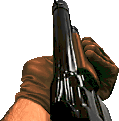
Random side note: in The Evil Dead the shotgun is single-barrel, but in Evil Dead 2 and beyond it’s double barrel, and the Doom games follow that same pattern (although you still have the original one)! Definitely unintentional, still fun!
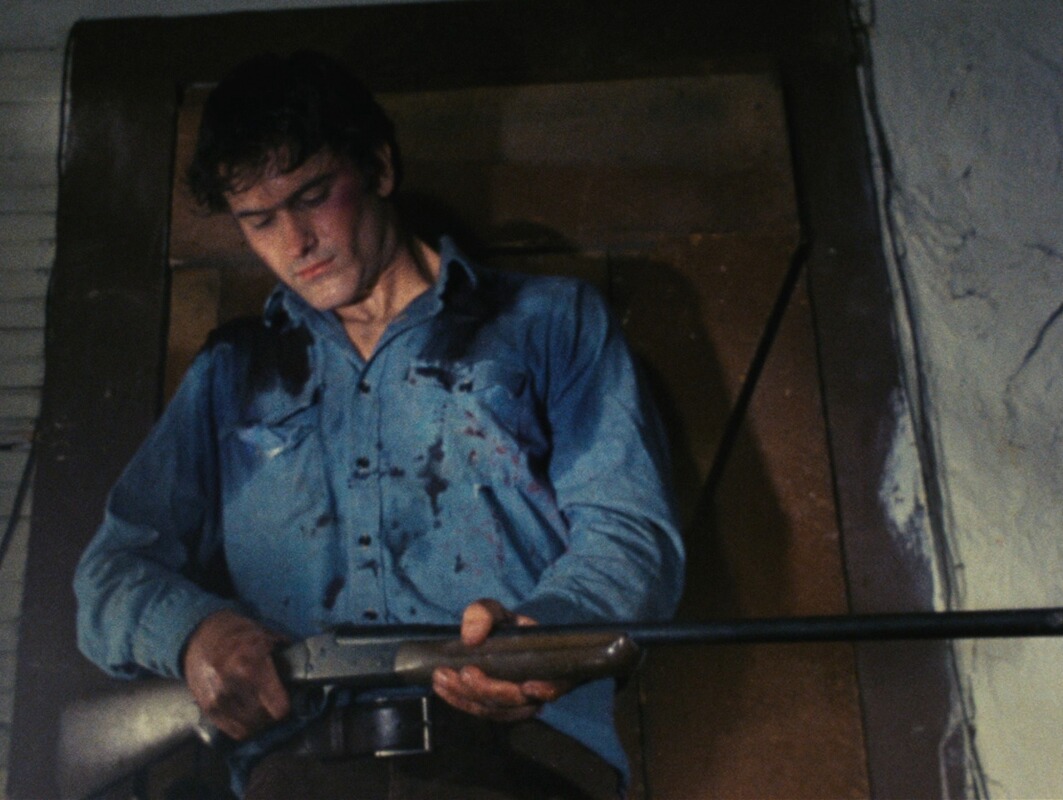
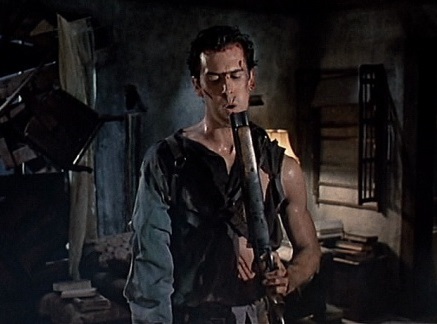
Back to Doom, along with the shotgun you’re also provided two rapid-fire solutions, the **chaingun** and **plasma rifle**. The chaingun is quite strong and satisfying, being good at hurting enemies enough to sometimes stop them from attacking, making it a fantastic counter to lost souls. It feels particularly good to snag initially because over the course of the first few levels you’ll have picked up tons of bullet ammo that you haven’t used any of, and suddenly you get a weapon that can truly utilize it. The plasma rifle is, in most ways, just a straight up upgrade to the chaingun, but it never replaces it due to its ammo type being less common. Best saved for big enemies and sticky situations.


I’m not spending too much time on the **rocket launcher** because it is exactly what it sounds like. Your power weapon. Shoots rockets. They go boom. Gibs* galore. Feels fantastic. Nuff said.
Gib (/jib/) - Short for giblets, refers to killing an enemy so hard they explode into gore. Typically the most satisfying thing you can do in any game that has the mechanic.
Sometimes I like to use it to just completely vaporize one zombieman. Just as a treat.

Hey, remember when I mentioned the Evil Dead series several times in relation to this? CHAINSAW! I mean, it’s not great as far as fps melee goes, but come on, the genre had only just been invented! First person shooters still haven't figured out melee combat! CHAINSAW!!! This thing will basically completely stunlock any enemy you hit it with, and is particularly great on pinkies. The only reason it’s not an automatic win button is that you can’t just run up to an enemy shooting projectiles and also you can very much still get hit while you’re attacking.

Finally, the moment you’ve all been waiting for. The mother of all guns, weapon of choice for actor and former wrestler Dwayne “The Rock” Johnson, from the imagination of Roald Dahl, I present to you… the BFG 9000! Have you ever looked at a gun and thought, gee, I wish that was bigger? Have you ever looked at a bullet and thought, gee, I wish that was a giant glowing ball of green plasma that could basically vaporize anything, and had really weird and janky mechanics for dealing damage? We got you covered. This is the other reason for you to save your cell ammo. It is just an absolutely absurd weapon. Play your cards right, and this can clear an entire room in one shot. What were they THINKING? And how do I think like that?

Looking at all these mechanics individually, it’s just so impressive to me how ahead of the curve Doom was. It was only about the second iteration on a genre that is now so ubiquitous you barely even have to mention it, and was literally the first one to figure out how to go up and down. There is no frame of reference for most of Doom’s features. This IS the frame of reference. So many games still miss the mark, but Doom had its mechanics locked down from the start.
The level design, while mostly carrying this energy, is more of a mixed bag.
Doom is split into three episodes: Knee-Deep in the Dead, The Shores of Hell, and Inferno. Knee-Deep in the Dead is by far the strongest, and The Shores of Hell is just fine, but once you reach Inferno it starts to get dubious.
(There is also a fourth episode, Thy Flesh Consumed, but it was made after the game's initial release and I have not fully played it, and so as such it will not be covered here.)
Doom's levels are, in their most essential form, monster-filled mazes. It's less that the level is designed to lead you to more enemies, and more that the enemies are placed to impede your progress to finding the end of the level, although both concepts apply. With the primary exception of the iconic Hangar (E1M1), most levels follow a structure of hunting for keys to unlock doors. Usually, you'll find the doors before you find the key, making the moment of picking it up much more rewarding as you get to uncover whatever was being hidden from you before. Occasionally, such as in Deimos Anomaly (E2M1), you'll notice a locked door that isn't required to reach the exit, leading you to more closely look for the other easily overlooked but vitally important element of level design: secrets.

I've seen many other games, especially shooters, do secrets in levels, but I'll always love these classic ones the most. There's just something so satisfying about them. The satisfaction of noticing a weird wall texture and having that perception pay off, the little stinger that plays, the "A secret is revealed!" message. Plus, of course, getting extra ammo and health, because that's the real reason you're looking out for these. That, and it's satisfying to see the 100% on the level clear screen. Even more fun are the secrets early on in each episode that give you weapons earlier than you'd get them otherwise. You can even pick up the plasma rifle at the very start of episode 2!
The problem that Doom's levels run into is the low enemy variety, which can result in things feeling a bit repetitive. To combat this, it helps for levels to have unique quirks to them, something that allows them to stick out, even if its small. Sometimes these things are fun, but other times, especially in Inferno, they're just fucking obnoxious. I've played through the first two episodes start to finish tons of times. I think I've only completed Inferno once, because I just get tired of it.
Hell Keep (E3M1) contains a section where you cross a bridge over lava to get to the shotgun, except it starts to collapse once you step on it, except your exit is just an illusory wall on the other side, but you have no way of knowing that without just walking into it, and it's not a huge deal it's just. what? Unholy Cathedral (E3M5) has a teleporter puzzle where three of the teleporters just take you to the middle of the room and it's not a puzzle you're just running into shit until it does what you want. It's dumb. That's not even getting started on.... eugh. Slough of Despair (E3M2). The worst level in the game. Slough of Despair hurts my soul. Go fuck yourself, Sandy. "Ooh, what if we had a level shaped like a hand?" What if you shut the fuck up?
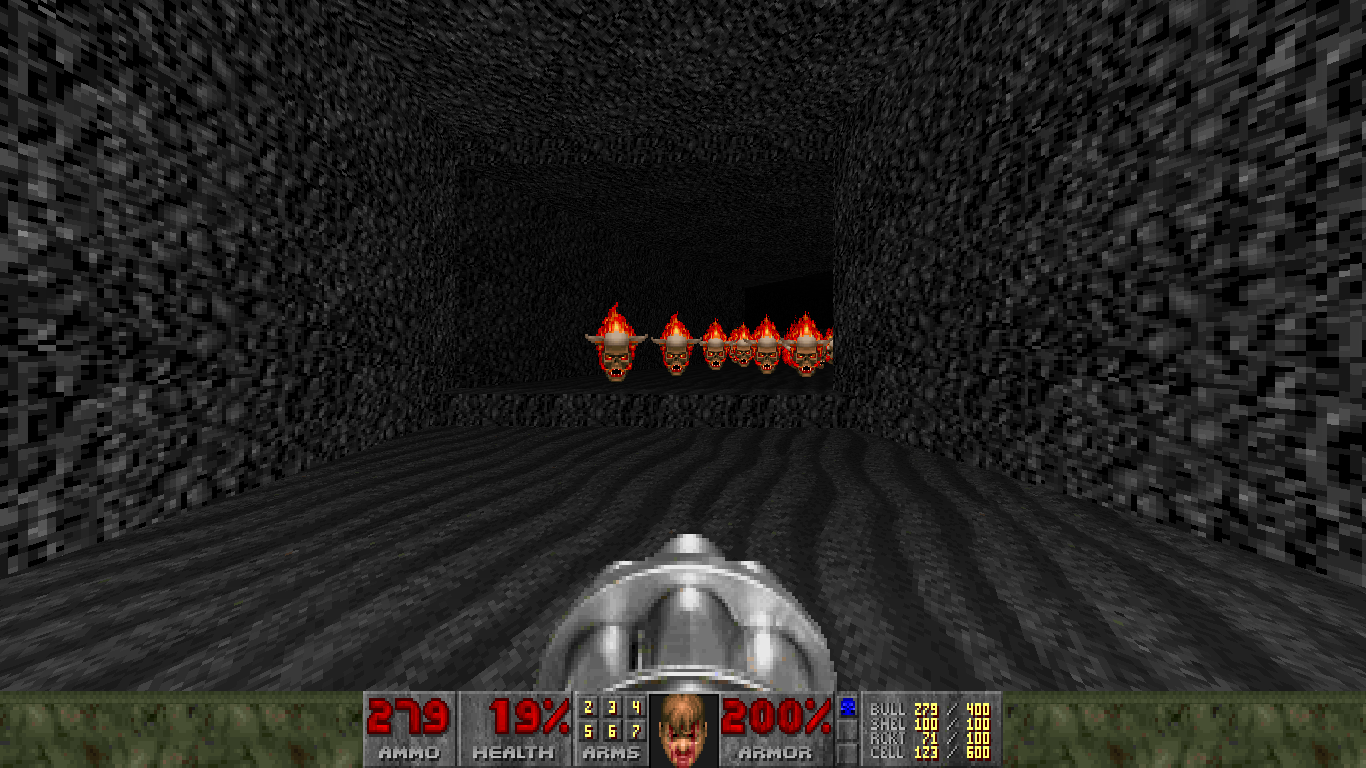
The worst of Doom's level design isn't as bad as the worst of Doom 2, but its best isn't as good as Doom 2's best either. At least episode 3 finally gives you the BFG.
Each episode ends with a boss fight, the game's one aspect that I think sucks. They're not terrible, each boss is interesting and has fantastic presentation, they're just... eh? I definitely prefer a boss that's too easy to a boss that's so hard I have to turn on cheats (looking at you, Doom 2), but still.
As previously mentioned, Knee-Deep in the Dead closes with a fight against two barons of hell, who emerge from two large boxes to jumpscare the player in my favorite setpiece of the game. Rarely does the level design in this game look awesome, but here it totally does.
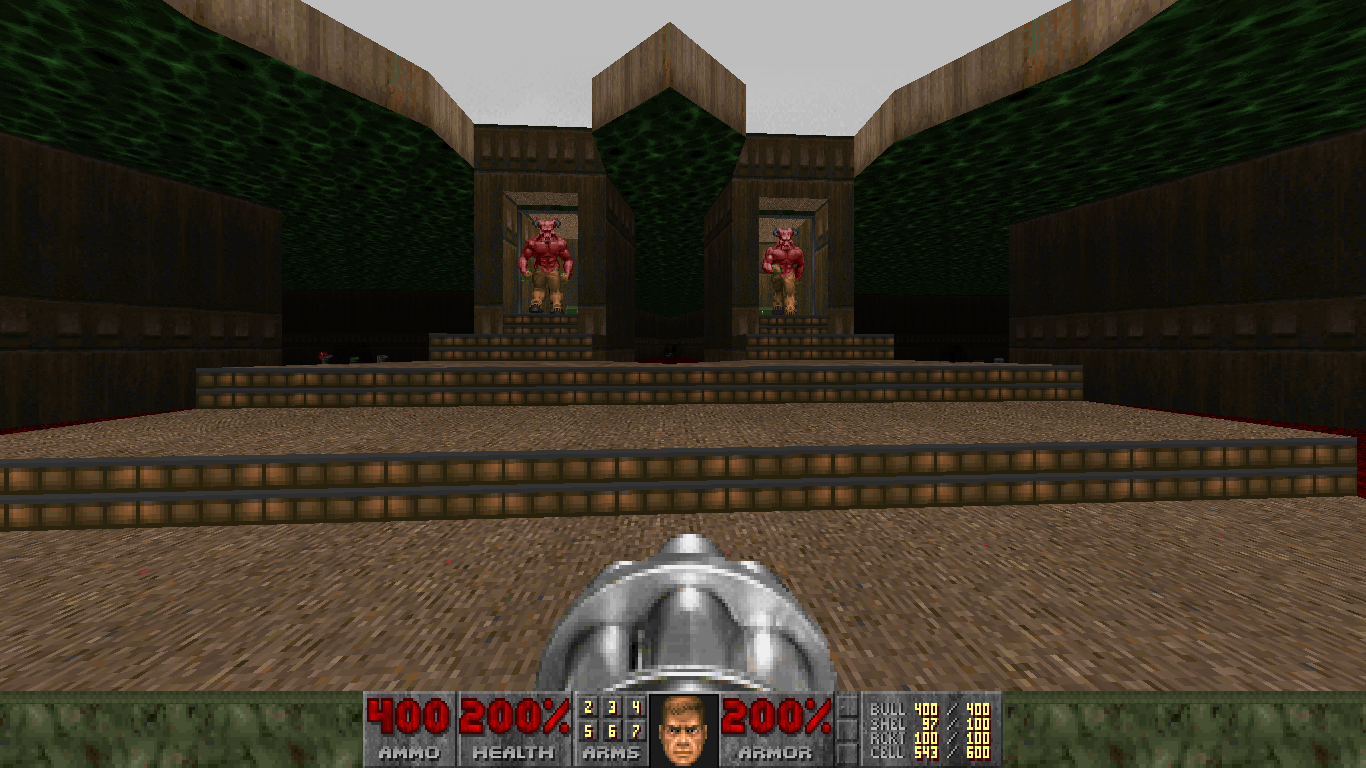
By the time you finish The Shores of Hell, you've already gotten used to barons as a reoccurring enemy, so now they're throwing the big guns at you. Tower of Babel (E2M8) starts off in a tiny room with four doors. Baron corpses hang from each one, just to give you a sense of what's coming.

You walk through one and are met with a massive cache of rocket ammo. Then... you hear it. stomping. maybe distant, maybe close. You walk out into a massive arena, and then you see it. The biggest and baddest demon you've faced thus far... the CYBERDEMON. If you're a first time player and his grand introduction has succeeded in turning your pants brown, you will notice that the rockets he fires have a tendency to vaporize you on impact. He's big, he's bad, he's awesome, and I love him.

He's actually not that hard to fight, just circle strafe to dodge the rockets and slam down as much plasma fire as possible. Still! Nails the presentation!
Keeping in theme with its underwhelming vibe, Inferno has a final boss that's just. There. Despite the awesome name and full auto shotgun, the spider mastermind is a really uninteresting boss. No menacing buildup, much goofier music, and the boss itself goes down really easily. id Software has a track record of bad final bosses, and this is one of them, although it is not even close to their worst.

I hate to leave this review on a negative like that. It's much easier to talk about the bad parts of something than to define what makes the good parts so good, and it's important to note here that the vast majority of the time the good parts of Doom immensely overshadow the bad. We are so deeply fortunate that the worst parts of this game is the level design, because when a game has 3 decades worth of levels made by a massive and deeply passionate modding community, it absolutely matters the least. What's important is that the core gameplay loop is good, and it is. The only reason that the 1993 game doesn't have more fan content is that the base content of Doom 2 makes it a thousand times better as a canvas for modding. Its additions to the enemy roster and the one glorious new gun it adds are the reason why I keep saying things like "near-perfect" about this game. Doom 2 is a review for another time, though.
Doom rocks!!!!! I am so happy we live in a world with this game!!!! The original may not have as much emotional significance to me, having gotten into the series from DOOM (2016), but I still have so much love and appreciation for it in my heart. I love video games.

Doom is Boom.
